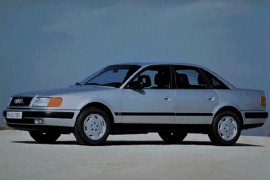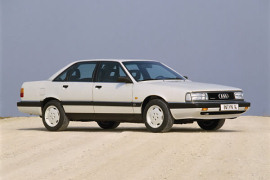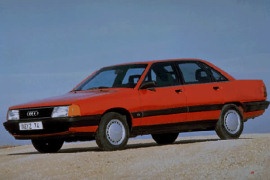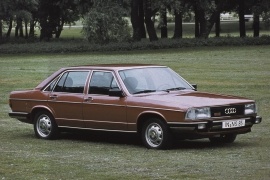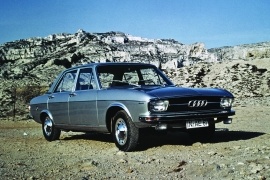AUDI 100/ 200 Models/Series Timeline, Specifications & Photos
First production year: 1968
Engines: Gasoline, Diesel
In 1991, Audi introduced the last generation of the A4 lineup before changing the nameplate to the A6 and offering its mid-size segment contender as a sedan or a station wagon.
The sedan was obviously the most interesting offer since it aimed directly at the BMW 5 Series and the Mercedes-Benz E-Class. Unlike its main competitors, the 100 was offered a front- or an all-wheel drive system, which proved to be a better choice, especially during winter. By 1991, the four-silver-rings brand was already known, but it was still not completely recognized as a premium brand.
When Audi penned the 100, it aimed to get a classic look with sleek, curved lines. Its tilted front fascia with squared flush to the grille headlights offered an aerodynamic look. In addition, the slightly ascending beltline ended on the flat, and the straight trunk was also a sign of dynamism. Unlike other vehicles from its segment, it provided a third-side window installed behind the rear doors. The big taillights emerged from the quarter panels to the trunk lid at the back.
Inside, Audi managed to create a spacious cabin for five full-grown adults. The carmaker added the best materials available for those times. There were no hard-plastic elements in the main areas. In addition, the dashboard, the sloped center stack, and the door cards were covered with soft materials, pleasant to touch. At the back, the three-seat bench was tilted and comfortable for long trips.
Under the skin, Audi installed a wide choice of gasoline and turbo-diesel engines. They sent their power to the front or all-wheels via a five-speed manual or a four-speed automatic.
AUDI 100 (C4) 2.0L 4AT FWD (101 HP)
AUDI 100 (C4) 2.0L 4AT FWD (115 HP)
AUDI 100 (C4) 2.0L 5MT FWD (101 HP)
AUDI 100 (C4) 2.0L 5MT FWD (115 HP)
AUDI 100 (C4) 2.0L quattro 5MT AWD (115 HP)
AUDI 100 (C4) 2.3 quattro 5MT AWD (133 HP)
AUDI 100 (C4) 2.3L 4AT FWD (133 HP)
AUDI 100 (C4) 2.3L 5MT FWD (133 HP)
AUDI 100 (C4) 2.6L 4AT FWD (150 HP)
AUDI 100 (C4) 2.6L 5MT FWD (150 HP)
AUDI 100 (C4) 2.6L quattro 4AT AWD (150 HP)
AUDI 100 (C4) 2.6L quattro 5MT AWD (150 HP)
AUDI 100 (C4) 2.8L V6 4AT FWD (174 HP)
The Audi designers threw away all the other drawings from previous models when they started to work on the third generation of the Audi 100, and the result paid off.
When the third generation of the 100 was introduced in 1984, it was the most aerodynamic production car in the world. With a Cx drag-coefficient of just 0.30, it was better than any other sports car on the market, although the 100 was a four-door sedan, built for comfort and long journeys.
The squared second generation of the 100 was forgotten. The new design was aerodynamically enhanced up to the smallest exterior detail. The headlights were flush to the hood's edge and with the wide grille. The windows were flush to the frames and the glued windshield didn't make any turbulence. The 100 featured a flat hood, curved side panels, and a short and flat trunk lid. The 200 version featured enlarged wheel-arches to accommodate wider wheels.
Inside, the 100 offered a roomy cabin, fit for five passengers. Though, the rear center passenger had to stay on top of the transmission tunnel. The Audi 100 featured a different interior than its 200 sibling. The dashboard for the 100 featured a smaller instrument cluster, while the 200 version featured an extended version, to accommodate more dials. The central locking system was pneumatic. The 100 was the version bought mostly for family use, while the 200 was a direct hit against BMW, Mercedes-Benz, and Alfa Romeo on the premium segment.
The engine range was different for the twin models. While the 100 was offered with economical engines, the 200 range was offered exclusively with turbocharged units.
AUDI 200 2.2 quattro 5MT (200 HP)
The first generation was released in 1968 and the nameplate of Audi 100 was assigned due to the engine’s power output of 100 hp. A coupe version was also available and a 2-door saloon were also offered.
The Audi 100 released in 1982 was a mid-size 4-door luxury sedan, with a front engine and available with all-wheel-drive or front-wheel-drive system. The coupe version was discontinued and the Avant was introduced as a station wagon, with an available folding 3rd row.
The Audi 100 used a galvanized steel construction which ensured longevity and rust-resilience. The car featured the Audi’s Procon-Ten safety system, a feature that increased the driver’s protection in case of a front-crash, by pulling the dashboard and the steering wheel up and away from his face.
For 1982, the car was incredibly aerodynamic, with a drag coefficient of only 0.30, being the most aerodynamic car on sale at that time.
The Audi 100 was available with Audi’s Quattro AWD system. The car was available with 8 gasoline engines with a displacement between 1.8-liters to 2.3-liters developing power ranging between 75 to 165 hp.
The best acceleration was achieved by the Audi 100 2.2-liter Quattro, being able to reach 100 km/h in 8 seconds.
The Audi 100 represented a big step forward for the cars produced in the 90’s.
AUDI 100 (C3) 1.8L 3AT FWD (75 HP)
AUDI 100 (C3) 1.8L 3AT FWD (90 HP)
AUDI 100 (C3) 1.8L 4MT FWD (75 HP)
AUDI 100 (C3) 1.8L 4MT FWD (90 HP)
AUDI 100 (C3) 1.8L 5MT FWD (75 HP)
AUDI 100 (C3) 1.8L quattro 5MT AWD (90 HP)
AUDI 100 (C3) 1.9L 3AT FWD (100 HP)
AUDI 100 (C3) 1.9L 5MT FWD (100 HP)
AUDI 100 (C3) 2.0L 3AT FWD (115 HP)
AUDI 100 (C3) 2.0L 5MT FWD (115 HP)
AUDI 100 (C3) 2.2L 3AT FWD (138 HP)
AUDI 100 (C3) 2.2L 5MT FWD (138 HP)
AUDI 100 (C3) 2.2L quattro 5MT FWD (138 HP)
AUDI 100 (C3) 2.2L Turbo 3AT FWD (165 HP)
AUDI 100 (C3) 2.2L Turbo 5MT FWD (165 HP)
AUDI 100 (C3) 2.2L Turbo quattro 5MT AWD (165 HP)
AUDI 100 (C3) 2.3L 3AT FWD (136 HP)
After Audi successfully convinced Volkswagen's management that it deserved a better chance in life than just being used as a production facility for the Beetle, the carmaker improved its lineup and introduced the second generation of the 100 lineup in 1976.
In the mid-'70s, there were two main Premium brands in Germany: BMW and Mercedes-Benz. Opel still struggled to get a slice of the pie, while Audi was considered just a nicer Volkswagen.
From the design point of view, it was a squared-looking vehicle where the form followed the function. Its rectangular headlights were easy to fit into the flat front fascia, while the front bumper didn't have the same chromed look as on other vehicles. All of a sudden, customers started to appreciate them more than the regular chromed-covered bumpers. It still featured shiny trims around the windows and on the car's sides, but they were not that bold. Another important design element was the third row of windows behind the rear doors, which brought more light to those seated in the back. That was a feature that neither BMW nor Mercedes-Benz didn't offer.
Inside, thanks to the front-wheel drive system, the car offered enough legroom for the front passengers and a flat floor. Moreover, the rear bench could comfortably accommodate three occupants. The clean, minimalist dashboard design offered a panoramic view for passengers and a squared instrument cluster for the driver. On the center stack, the carmaker installed a radio and ventilation controls.
Under the hood, there was a fuel-efficient 1.6-liter engine. The efficiency scale also counted a choice of two-liter diesel units. The most potent version was appreciated, with the 136 ponies squeezed from a fuel-injected 2.1-liter inline-five.
The 1968 Audi 100 was the beginning of a beautiful story of luxurious and fast sedans built by the German car-maker. It was the first vehicle built together with Volkswagen.
The Audi 100 was developed on the Volkswagen C1 platform. There was a strange history behind the car, with a complex plot organized by Audi management to convince the Volkswagen Board to let them build an executive sedan. The four-round headlights, the slightly curved lines of the bodywork, and the spacious cabin rolled off the factory lane in 1968. It was a huge success and it was sold in almost 900.000 units until 1976 when it was replaced. The 100 name came from the power output of its top version.
Inside, the spacious 100 offered room for five adult passengers and ensured a comfortable ride. Unlike most of the other car-makers from that era, it featured a front-wheel-drive architecture. It meant that there was no transmission tunnel inside the vehicle. In the U.S. it was advertised as offering “just about the same headroom and legroom as the Rolls-Royce Silver Shadow”.
The engine range featured a 1.8- and 1.9-liter units. Most of them were feed via a carburetor, but in 1975 there was a fuel-injection system added to the lineup. The standard transmission was a 4-speed manual, with a 3-speed automatic joining the range later on. The in-board disc-brake system was another novelty, a technology inspired by the Porsche 917 race-car.
